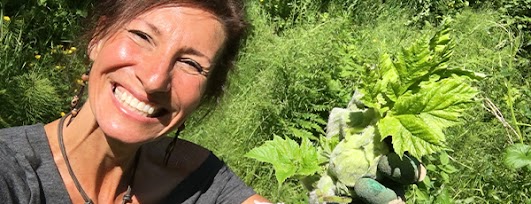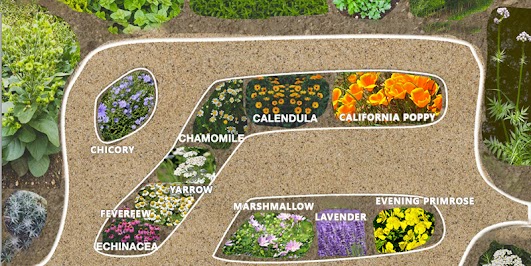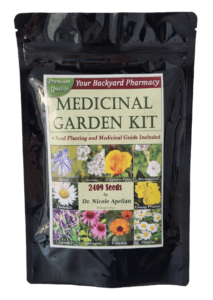
In a crisis, people will turn to plants once again for both food and medicine. And there are some plants that will vanish faster than all others.
So the only way to make sure you have them when you need them is to grow them in your own backyard.
What is Medicinal Garden Kit?
Medicinal Garden Kit, created by renowned herbalist Nicole Apelian, Ph.D., is a high-quality medicinal seed kit tailored to encourage individuals to take control of their health using natural plant remedies.
Perfect for both gardening novices and seasoned enthusiasts, it offers an accessible approach to incorporating the benefits of herbal medicine into daily life.
The kit provides the essentials for growing medicinal herbs, making natural health care accessible to everyone.
Who is Nicole Apelian? And What are her qualifications?

Nicole Apelian is a true expert in natural healing, combining her training as a biologist, herbalist, and survival skills instructor.
She gained her extensive knowledge not only through her academic studies but also by living with the San Bushmen in the Kalahari Desert, where she learned traditional herbal remedies.

At 29, Nicole faced a personal health challenge: she was diagnosed with Multiple Sclerosis. Finding limited relief from standard treatments, she turned to medicinal herbs.
This change greatly improved her health and altered her view on medicine, successfully managing her condition with natural methods.
“Nature has always been my greatest teacher. Living with indigenous communities, I discovered the profound wisdom of the natural world and the healing power it holds. My journey has been a blend of science and ancient wisdom, bridging the gap between modern knowledge and the age-old remedies that have sustained humanity for centuries.”
Nicole Apelian
Inspired by her own experiences, Nicole created Medicinal Garden Kit.

Benefits of Medicinal Garden Kit
- Wide Variety of Healing Herbs:
- Seeds for ten different medicinal herbs, catering to a range of health needs
- High-Quality Seeds:
- Non-GMO, premium quality seeds for effective growth and potent remedies
- Comprehensive Guide Included:
- Easy instructions for planting, harvesting, and utilizing herbs for health benefits
- Accessible to All:
- Suitable for both beginners and experienced gardeners
- Promotes Self-Reliance:
- Enables the cultivation of personal natural remedies, reducing dependence on commercial pharmaceuticals
- Environmentally Friendly:
- Supports sustainable and eco-friendly gardening practices
- Mental and Emotional Wellness:
- The act of gardening offers therapeutic benefits like stress reduction
- Space-Efficient:
- Ideal for various gardening spaces, from small urban balconies to larger backyard gardens
What Medicinal Seeds are in the Kit?
In this kit, you’ll find:
- Chamomile
- Peppermint
- California Poppy
- Yarrow
- Feverfew
- Chicory
- Echinacea
- Marshmallow
- Evening Primrose
- Lavender
This package offers you more than you could ask for:
A natural antibiotic, a herbal painkiller, a wound healer, and many more.




Included with your seed kit is a complimentary copy of the Herbal Medicinal Guide: From Seeds to Remedies.

This valuable guide offers detailed instructions for transforming the 10 included plants into a variety of herbal preparations.
Whether you’re interested in creating tinctures, ointments, salves, poultices, decoctions, infusions, or essential oils, this guide covers it all.
It’s designed to be easy to follow, making it perfect for beginners in herbal medicine as well as more experienced practitioners.
Pricing and Ordering Your Medicinal Garden Kit

Customers can order the Medicinal Garden Kit with complete confidence, as it’s supported by an extensive 365-day money-back guarantee.

You can start your journey towards a natural, homegrown pharmacy today, absolutely risk-free.
By clicking below, secure the Medicinal Garden Kit now!
Growing Your Medicinal Garden
Step 1: Choose a Sunny Spot

Sunlight Matters: Most medicinal herbs thrive in full sunlight. Select a location in your backyard that receives at least 6 to 8 hours of direct sunlight daily. If your space has partial shade, choose herbs that tolerate less sun.
Space Planning: Consider the space needed for each herb. Some herbs, like lavender and echinacea, can grow quite large, so plan accordingly to avoid overcrowding.
Step 2: Soil Preparation
Well-Drained Soil: Ensure your soil has good drainage to prevent waterlogging, which can harm herb roots. If your soil doesn’t drain well, consider raised beds or containers with well-draining potting mix.
Soil Quality: Test your soil’s pH and nutrient levels to ensure it’s suitable for herb cultivation. Amend it with organic matter like compost to improve fertility.

Step 3: Planting the Seeds
- Spacing Matters:
- Follow the seed packet instructions for proper spacing between plants. Some herbs, like yarrow and feverfew, require more room to grow.
- Depth:
- Plant seeds at the recommended depth, typically about 1/4 to 1/2 inch deep, but check the specific requirements for each herb.
- Watering:
- Gently water the soil after planting, keeping it evenly moist but not waterlogged. Watering with a gentle spray helps prevent disturbing the seeds.
Step 4: Watering and Care
- Consistent Moisture:
- Herbs prefer consistent moisture, so establish a regular watering routine. Avoid letting the soil dry out completely between watering.
- Weeding:
- Regularly weed around your herbs to prevent competition for nutrients and space. Mulching with organic materials like straw can help suppress weeds.
- Fertilize Sparingly:
- Herbs generally don’t require heavy fertilization. Use organic fertilizers sparingly to avoid excessive growth or reduced potency.
Step 5: Harvesting and Saving Seeds
- Harvesting:
- As your herbs mature, harvest leaves, flowers, or roots as needed. Be mindful not to remove more than one-third of the plant at a time, allowing it to continue growing.
- Seed Collection:
- Allow some plants to go to seed. When seeds are fully mature and dry, collect them for future planting or sharing with fellow gardeners.
- Storage:
- Store collected seeds in a cool, dry place in labeled envelopes or containers. Properly stored seeds can remain viable for several years.
Potential Challenges and Solutions:
- Pest Control:
- Keep an eye out for common garden pests like aphids and caterpillars. Use natural methods like neem oil or companion planting to deter pests without resorting to chemicals.
- Disease Prevention:
- Proper spacing, good airflow, and healthy soil can help prevent diseases. If issues arise, use organic treatments like copper spray or sulfur dust.
- Overwatering:
- Avoid overwatering, which can lead to root rot. Ensure good drainage, and water herbs only when the soil surface feels dry to the touch.
- Extreme Weather:
- During heatwaves or cold snaps, provide temporary shade or protection for your herbs. Greenhouse or mini greenhouse cultivation can also extend the growing season and protect against weather extremes.
By following these steps and addressing potential challenges proactively, you can nurture a thriving medicinal garden filled with the healing herbs you’ve carefully selected.
Your journey to herbal abundance is an enriching experience that brings you closer to the healing wonders of the natural world.
Extended Growing in a Greenhouse
For those looking to take their medicinal herb cultivation to the next level, the addition of a greenhouse offers a myriad of advantages that can significantly enhance your gardening experience.
Don’t Miss: Best Greenhouses Deals
Advantages of Using a Greenhouse
1. Extended Growing Seasons: One of the most apparent benefits of a greenhouse is the extension of your growing seasons. By providing a controlled environment, a greenhouse allows you to start planting earlier in the spring and continue harvesting well into the fall, or even throughout the entire year, depending on your location.
2. Protection from Harsh Weather: Unpredictable weather can wreak havoc on your outdoor garden. A greenhouse acts as a shield against adverse conditions like heavy rain, hail, strong winds, and temperature fluctuations. Your herbs are safe from the elements, ensuring their health and vitality.
3. Pest and Disease Control: Greenhouses provide a barrier against common garden pests and diseases. With fewer intruders, you can reduce the need for chemical pesticides and focus on organic, natural pest management methods.
4. Optimized Growing Conditions: You have precise control over the environment within your greenhouse. You can adjust temperature, humidity, and ventilation to create the ideal conditions for your herbs, resulting in healthier, more robust plants.
5.Conservation of Resources:Greenhouses are efficient in conserving resources like water and fertilizer. The controlled environment reduces water wastage, and nutrients are utilized more effectively, contributing to eco-friendly gardening.
Selecting and Setting Up Your Greenhouse:
- Size and Style: Determine the size and style of your greenhouse based on available space and your gardening goals. Consider factors like the number of herbs you want to grow, the space for walkways, and potential expansion.
- Location: Place your greenhouse in an area that receives ample sunlight throughout the day. South-facing locations are often ideal for maximizing sunlight exposure. Ensure a level foundation for stability.
- Ventilation: Adequate ventilation is crucial for regulating temperature and humidity. Install roof vents and side vents with automatic openers to ensure proper airflow.
- Heating and Cooling: Depending on your climate, you may need heating and cooling systems to maintain the desired temperature range. Options include electric heaters, fans, and shade cloth for cooling.
- Shelving and Benches: Consider adding shelving or benches to optimize space and provide suitable surfaces for potting, storing supplies, and organizing your plants.
- Watering Systems: Invest in a reliable watering system, such as drip irrigation, to ensure consistent moisture levels. Automatic timers can help maintain an appropriate watering schedule.
- Greenhouse Covering: Choose the right greenhouse covering material, such as polycarbonate or polyethylene, based on your climate and budget. Each material offers specific benefits in terms of insulation and durability.
- Pest Management: Implement preventive measures for pest control. Screen doors and windows, use sticky traps, and regularly inspect plants to catch and address issues early.
By carefully selecting and setting up your greenhouse, you can create an environment that optimizes growth and protects your precious medicinal herbs. Whether you’re a seasoned gardener or just starting your greenhouse journey, the advantages it offers will undoubtedly elevate your herbal cultivation experience.
Fertilizer Recommendations
Enhancing Growth with Safe and Balanced Nutrients
Choosing the right fertilizer is essential to ensure your medicinal garden thrives and produces healthy, potent herbs. It’s crucial to opt for safe, organic, and balanced fertilizers that provide the necessary nutrients without introducing harmful chemicals to your garden. Here, we present a selection of recommended fertilizers and their benefits:
- Espoma Organic Plant-tone:
- Benefits: Espoma Organic Plant-tone is a well-loved choice among gardeners for its balanced blend of natural ingredients. It enhances soil fertility, promotes healthy root development, and encourages robust herb growth. This slow-release, all-purpose fertilizer is ideal for maintaining soil health.
- Dr. Earth Organic Flower Girl Bloom Booster:
- Benefits: Designed to boost flowering and fruiting, Dr. Earth Organic Flower Girl Bloom Booster contains beneficial microorganisms that enhance soil biology. It’s rich in essential nutrients like nitrogen, phosphorus, and potassium, ensuring bountiful herb yields and vibrant blooms.
- FoxFarm Grow Big Liquid Fertilizer:
- Benefits: FoxFarm Grow Big Liquid Fertilizer is an excellent choice for gardeners looking for a liquid fertilizer option. It’s packed with essential macronutrients and trace elements that promote lush foliage, strong stems, and overall plant vigor. This fertilizer is versatile and suitable for both indoor and outdoor gardens.
- Gaia Green All Purpose 4-4-4 Fertilizer:
- Benefits: Gaia Green All Purpose 4-4-4 Fertilizer is an organic, slow-release option that nourishes your herbs steadily over time. With balanced nitrogen, phosphorus, and potassium content, it supports overall plant health, root development, and resistance to stress.
- Neptune’s Harvest Fish & Seaweed Fertilizer:
- Benefits: Neptune’s Harvest Fish & Seaweed Fertilizer combines the benefits of fish hydrolysate and seaweed extracts. This organic fertilizer enriches the soil with essential micronutrients, vitamins, and amino acids. It promotes vigorous growth, enhances stress resistance, and improves soil structure.
These recommended fertilizers are not only safe for your herbs but also contribute to soil health and sustainability. When using any fertilizer, it’s essential to follow the application instructions on the product label and avoid over-fertilization, as this can harm your plants. By choosing these balanced fertilizers, you’ll provide your medicinal herbs with the nutrients they need to thrive and become the vibrant, potent allies you seek in your wellness journey.

